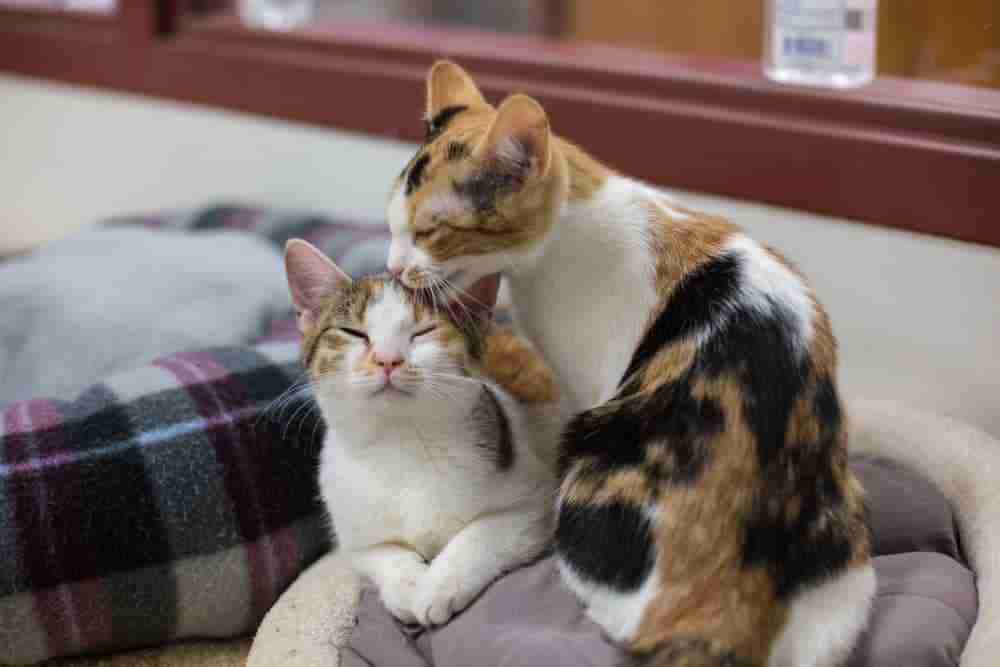Your cats behave themselves when you’re around, but the moment you step out of the door to the office, things change around the house.
If you have a couple of cats, chances are one of them plays the dominant role in the feline hierarchy of your home. Identifying the alpha dog in the pack is easy, but it’s challenging with cats.
Your cat uses a different set of tactics to gain and maintain dominance over the others in the household. From hissing to fighting, there are plenty of behavioral signs telling you which cat is the dominant feline around the house.
This article unpacks everything you need to know about understanding the feline hierarchy in your home.
How To Tell Which Cat Is Dominant?
You might not actually know at first glance which cat is dominant in your house if your cats live peacefully together.
In such instances, the rule of thumb is that either the maternal matriarch is the dominant cat or the largest cat – which is often male.
In feral cat colonies, the mothers occupy the dominant positions and largest sons next followed by younger and smaller cats. Male tom cats live separately and battle for dominance with other male cats.
How can you spot the dominant cat? The dominant cat will usually instigate bunting on other cats – head butting for scenting purposes. The dominant cat will look to spread scent and claim property and this is what bunting is.
Additionally, cats lower in the social hierarchy will body rub cats higher in the hierarchy, never the other way around.
The dominant cat will usually always eat first and if they do not have separate bowls may edge other cats aside before letting socially less dominant cats eat.
Threatening or Defensive Posture and Behavior
What about cats that are new to the hierarchy? Or neighboring cats that wander into the territory? Or growing male cats that rise through the hierarchy – what signs of dominance do they display?
In these instances, cats assert their dominance by threatening other cats using posture displays. The cat might stand its hair up and arch its back. This behavior is a sign of intimidation to the other felines in your household.
As the owner, these displays of cat dominance might seem silly, but it’s an essential part of your cats getting along with each other.

If more than one cat is trying to assert dominance around your house, it could end in loud vocal warnings and a spectacular fight.
If your cats do start fighting, there’s nothing you can do. Any attempt to separate them results in them biting or scratching you and a trip to the emergency room in severe instances.
However, cats don’t always resort to violence when sorting out the hierarchy in your home. Some may simply arch their backs, or they might stalk each other around the house.
Marking Territory
Cats have specific glands they use to spread their scent around their territory. If your cats aren’t neutered or spayed, they’ll likely stink up your home, spraying on everything they can find.
You’ll notice similar behavior when your cat snuggles up to you and starts rubbing its face on you. It seems cute at the time, but the reality is it’s marking you with a scent to show it owns you.

And in a way, they do.
The scent your cat runs on you smells of, well, cat. However, while the smell from cat to cat is impossible for you to differentiate, cats find it easy to separate the smells and determine the source.
Scenting, rubbing, and spritzing are all methods facilitating the same task for your cat – spreading their scent around your home and on you.
If two cats in your home challenge each other for dominance, they repeatedly rub their scent in areas where the other cats do it. This action shows the other cats who’s the boss.
Catfights
Catfights are the worst display of domination. Cats rarely get into it with each other without displaying plenty of aggression before the fight.

If you see your cats about to fight, they’ll be circling each other, making loud growling sounds. Eventually, they go at each other with cat slaps, nips, and bites, and the victor will stay, will the submissive cat run away.
When cats fight, they typically avoid harming each other, especially if they live under the same roof. However, if a neighbor’s cat wanders into your yard, it could end in a bloody result.
In most struggles for dominance, the cats attempt to position themselves on top of the other, biting at the neck and soft parts of the tummy.
Catfights are often louder than they are violent, and it’s more of a show of dominance than a fight. In most cases, you won’t have to bother with a trip to the vet.
Competition For Food and Water
The dinner bowl is one of the prime areas for a showdown between your cats. If one cat feels they aren’t getting enough food and water, they’ll fight the other cat or cats for it.
Feeding your cats using separate bowls and in different areas of your home avoids this conflict between your kitty’s.
Remember to give your cats equal levels of attention. Feed them dome catnip individually, and stop the primal animal urge to “beat” each other to the food or water bowl.
Is There Such a Thing as an “Alpha” Cat?
Dominant cats also go by the moniker of the “Alpha” in your household. This is not like an alpha that runs a pack of dogs. More a case of the most dominant cat acting alone and above other cats without developing a following or pack. The alpha cat displays the following characteristics.
- The cat doesn’t listen to you or stop when you tell them to.
- The cat continues its bad behavior, even after punishment.
- The cat constantly fights with the neighborhood felines.
- The cat exhibits aggressive behavior in some circumstances.
- The cat demands food and playtime on its schedule, not yours.
Typically, Alpha cats don’t get along with other felines, and they also might have a problem with their owner. An owner can’t subjugate a dominant cat by out dominating – they will simply avoid you.
It’s challenging for owners to rectify and break alpha behavior. It’s in the nature of these cats to act dominant in all situations.
Every Cat’s Personality Is Different

Cats are like people, they have individual personalities, and no two are the same. This independent characteristic means that they never form a family-unit or bond with other cats the same way your dogs might.
While this lack of community in your cat makes them independent and, it also means they have no emotional skin in the game. If they start causing a fight with another cat, they can walk away without feeling like they lost.
In most cases, cats will avoid fighting. Since it can lead to trips to the vet’s office or even the death of one of the cats, most cats aren’t willing to put their life on the line for a fight.
As long as cats get what they need from you, they’ll avoid conflict. Cats only start fighting when they have no other option; in most cases, it’s when they are hungry and desperate for food.
What Is Dominant Behavior in Cats?

Identifying dominant cat behavior in your cats lets you take action before things get out of hand. The first step in neutralizing bad behavior is to understand your cat’s motivation and needs.
Cats’ primary motivation in life is finding food. If you ensure they always have a full bowl of kibble and plenty of fresh water, you take care of these needs, and there’s less reason for your cats to start fighting.
Some of the dominant behavior displays alpha cats use are there following.
- Rough, unwanted, or aggressive playtime.
- Aggression based on fear.
- It creates a conflict over spots in the litterbox or around the dinner bowl.
- A lack of exercise and boredom can lead to dominant behavior.
- Attention-seeking behavior.
- Past rewards reinforce the repetition of bad behavior.
How Do I Address Unruly Dominant Behavior in My Cats?
It’s possible to keep your cats from displaying dominant behavior by giving them what they need to live a happy life.
Make sure you give them the proper setup at home for playing and sleeping. Pay attention to your cats, and look to fulfill their needs for food, water, and shelter.
If your cat is bothering you for some attention and stimulation, don’t force them away. By rewarding the right behavior in your cat, you’ll start to eliminate any displays of dominance between your animals.
With the right strategy, you’ll create a loving home where all your cats get along with each other.
